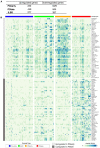Disease Duration Influences Gene Expression in Neuromelanin-Positive Cells From Parkinson's Disease Patients
- PMID: 34867188
- PMCID: PMC8632647
- DOI: 10.3389/fnmol.2021.763777
Disease Duration Influences Gene Expression in Neuromelanin-Positive Cells From Parkinson's Disease Patients
Abstract
Analyses of gene expression in cells affected by neurodegenerative disease can provide important insights into disease mechanisms and relevant stress response pathways. Major symptoms in Parkinson's disease (PD) are caused by the degeneration of midbrain dopamine (mDA) neurons within the substantia nigra. Here we isolated neuromelanin-positive dopamine neurons by laser capture microdissection from post-mortem human substantia nigra samples recovered at both early and advanced stages of PD. Neuromelanin-positive cells were also isolated from individuals with incidental Lewy body disease (ILBD) and from aged-matched controls. Isolated mDA neurons were subjected to genome-wide gene expression analysis by mRNA sequencing. The analysis identified hundreds of dysregulated genes in PD. Results showed that mostly non-overlapping genes were differentially expressed in ILBD, subjects who were early after diagnosis (less than five years) and those autopsied at more advanced stages of disease (over five years since diagnosis). The identity of differentially expressed genes suggested that more resilient, stably surviving DA neurons were enriched in samples from advanced stages of disease, either as a consequence of positive selection of a less vulnerable long-term surviving mDA neuron subtype or due to up-regulation of neuroprotective gene products.
Keywords: Parkinson’s disease; RNA sequencing; cell death; disease duration; gene expression; neurodegenerative disease; neuroprotection.
Copyright © 2021 Tiklová, Gillberg, Volakakis, Lundén-Miguel, Dahl, Serrano, Adler, Beach and Perlmann.
Conflict of interest statement
The authors declare that the research was conducted in the absence of any commercial or financial relationships that could be construed as a potential conflict of interest.
Figures






References
LinkOut - more resources
Full Text Sources
Molecular Biology Databases

